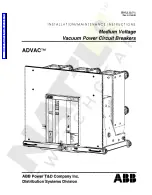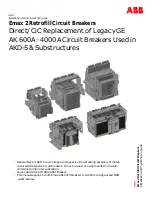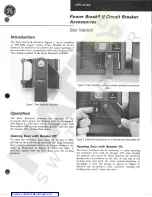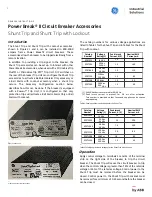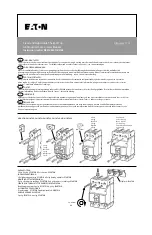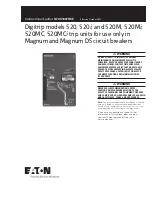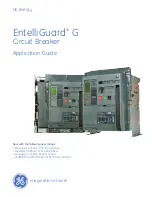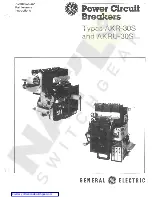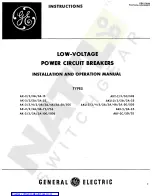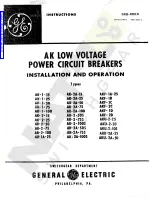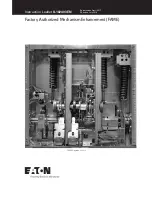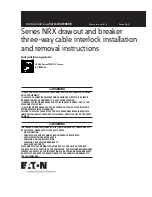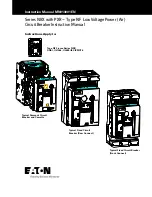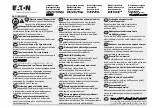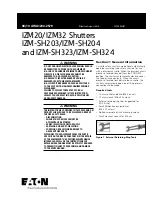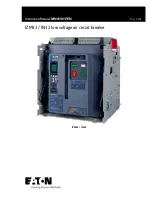
Anleitung für den Elektriker
- Der Einsatz eines Fehlerstromschutzschalters mit
Nennfehlerauslösestrom I
D
n größer als 0,03A
gewährleistet den Schutz gegen indirektes Berühren, nur
wenn der Erdanschluß laut den Vorschriften VDE 0100
ausgeführt und koordiniert worden ist.
- Hochempfindliche Fehlerstromschutzschalter (I
D
n
kleiner oder gleich 0,03A) gewährleisten auch einen
zusätzlichen Schutz gegen direktes Berühren.
- Der Fehlerstromschutzschalter muß in einer Verteilung
oder in einem Gehäuse, dessen Schutzart IP den
Umgebungs-und-Anwendungsbedingungen laut VDE
Vorschriften entspricht, montiert werden.
- Den Schalter laut Anleitung anschließen.
- Alle Verbrauchergeräte des zu schützenden
S t r o m k r e i s e s e i n s c h a l t e n . W e n n d e r
Fehlerstromschutzschalter auslöst nach Abschaltung
aller Verbraucher diese einzeln nacheinander
einschalten, um festzustellen welches Gerät die
Auslösung des Fehlerstromschutzschalters verursacht.
Nach Identifizierung des fehlerhaften Verbraucher,
diesen vom Stromkreis abschalten und überprüfen.
- Prüftaste betätigen. Der Fehlerstromschutzschalter,
wenn richtig montiert und angeschlossen, muß auslösen.
- Bei sehr ausgedehnten elektrischen Anlagen, kann auf
Grund der Fehlerströme gegen Erde eine Auslösung des
Schalters erfolgen. In diesem Fall die Anlage in zwei oder
mehrere Zweige teilen, wobei jeder Zweig von einem
Fehlerstromschutzschalter geschützt werden muß.
- Das höchste Schutzniveau wird erreicht, wenn alle
Verbraucher, die an die gleiche Erdung angeschlossen
sind, von Fehlerstromschutzschaltern geschützt werden.
- Dieses Anweisungsblatt abtrennen und dem
Benutzer den Teil "Anleitungen für den Benutzer"
hinterlassen.
D
Istruzioni per l'installatore
- Installando un interruttore differenziale a bassa
sensibilità (I
D
n maggiore di 0,03A), la protezione contro
i contatti indiretti é assicurata solo se esiste un impianto
di terra coordinato secondo la Norma CEI 64-8.
- Se l'interruttore differenziale é ad alta sensibilità (I
D
n
minore o uguale a 0,03A), é assicurata anche una
protezione addizionale contro i contatti diretti.
- "N.B. - La legge 46/90 prescrive che tutti gli
impianti siano dotati di impianti di messa a terra e
di interruttori differenziali ad alta sensibilità o di
altri sistemi di protezione equivalenti".
- Il differenziale deve essere installato in un quadro o
in un contenitore avente un grado di protezione IP
adeguato all'ambiente ed all'uso, secondo le
prescrizioni delle Norme CEI.
- Collegare l'apparecchio seguendo attentamente le
istruzioni.
- Inserire tutti i carichi del circuito da proteggere. Se il
differenziale interviene, ricercare, inserendo un carico
dopo I'altro, quale fra essi provoca lo scatto. lndividuato
il carico guasto, scollegarlo dall'impianto e verificarlo.
- Azionare il tasto di prova. Il differenziale, se
correttamente installato ed alimentato, deve scattare.
- Se l'impianto elettrico é molto esteso, sono possibili,
per effetto di correnti verso terra, aperture del
differenziale. In tal caso suddividere l'impianto in due o
più circuiti, proteggendo ciascuno con interruttore
differenziale distinto.
- Il più elevato livello di sicurezza si ottiene quando
tutte le utenze, che fanno capo allo stesso impianto di
terra, sono protette con interruttori differenziali.
- Importante : staccare e lasciare all'utente la parte
"Avvertenze per I'utente".
I
Instructions pour l'installateur
- Dans le cas de l'installation d'un différentiel ayant un
courant de fonctionnement différentiel assigné I
D
n >
0,03 A, la protection contre les contacts indirects est
assurée seulement si le circuit de terre est raccordé
conformément à la norme NF C 15-100.
- Si le différentiel a un courant de fonctionnement
différentiel assigné I
D
n
< ou = 0,03 A, il assure également
une protection contre les contacts directs.
- Le différentiel doit être installé dans un coffret ou
boîtier dont le degré de protection adapté aux conditions
ambiantes et à l'usage conformément aux prescriptions
de l'U.T.E.
- Raccorder le différentiel conformément aux instructions.
- Enclencher tous les appareils alimentés par ce circuit.
Si le différentiel déclenche, chercher l'appareil ayant
causé le déclenchement.
Déclencher tous les appareils, puis les enclencher
successivement.
Après identification de l'appareil défectueux, le
débrancher et le vérifier.
- Appuyer sur le bouton Test. Le différentiel correctement
raccordé et alimenté doit déclencher.
- Si l'installation est très étendue, les courants de défaut
à la terre peuvent provoquer le déclenchement du
différentiel.
Dans ce cas, partager l'installation en 2 ou plusieurs
circuits, en protégeant chaque circuit par un différentiel.
- Le niveau de protection le plus élevé est atteint lorsque
tous les appareils raccordés au même circuit de terre
sont protégés par des différentiels.
- Enlever cette partie de la notice et laisser à l'usager
la partie "Instruction pour l'usager".
F
Instructions for the electrician
- Applying a residual current circuit-breaker with a rated
residual operating current I
D
n
higher than 0,03A the
protection against indirect contacts is ensured only
when the earth circuit is laid out and coordinated
according to IEC Standard 364.
- If the residual current circuit-breaker has a rated
residual operating current I
D
n equal or less than 0,03A,
the protection is ensured also against direct contacts
with live parts.
- The residual current circuit-breaker has to be mounted
in units or boxes with a protection degree suitable for
the ambient and usage conditions according to the
relevant IEC Standards.
- Connect the residual current operated circuit-breaker
following carefully the instructions.
- Switch on all appliances of the circuit to be protected. If
the residual current operated circuit-breaker trips, find
the appliance that causes the tripping by switching on
one after the other all the appliances. After the
identification of the faulty appliance, disconnect and
check it.
- Press the test button. The residual current operated
circuit-breaker must trip if properly connected and
supplied.
- When the electric installation is very extensive, earth
leakage currents may cause the tripping of the residual
current operated circuit-breaker. In this case divide the
installation into two or more circuits, protecting each of
them with a separate residual current operated
circuit-breaker .
- The highest degree of protection is obtained when all
consumers connected to the same earth circuit, are
protected by residual current operated circuit-breakers.
- Cut off this part of the sheet and leave the part
"Instructions for the user" for the user.
GB
Instrucciones para el instalador
- Instalando un interruptor diferencial de baja
sensibilidad (I
D
n
superior a 0,03A), la protección contra
los contactos indirectos está asegurada sólo si existe
una instalación de tierra coordinada según el vigente
Reglamento.
- Si el interruptor diferencial es de alta sensibilidad (I
D
n
inferior o igual a 0,03A), está asegurada también una
protección adicional contra los contactos directos.
- El diferencial debe ser instalado en un cuadro o una
caja con un grado de protección IP adecuado al
ambiente y a su utilización, según las prescripciones
del Reglamento.
- Conectar el aparato siguiendo atentamente las
instrucciones.
- Conectar todas las cargas del circuito a proteger. Si el
diferencial interviene, localizar, conectando las cargas
una tras otra, cual de ellas provoca la desconexión.
Una vez separada la carga defectuosa, desconetarla
de la instalación y verificarla.
- Accionar el pulsador de prueba. Si el diferencial está
c o r r e c t am e n t e i n s t a l ad o y c o n e c t a d o, d e b e
desconectar.
- Si la instalación eléctrica es muy extensa, es posible
que por efecto de corrientes a tierra se produzcan
aperturas del diferencial. En tal caso subdividir la
instalación en dos o más circuitos, protegiendo cada
uno de ellos con un interruptor diferencial distinto.
- El nivel más elevado de seguridad se obtiene cuando
todas las cargas conectadas a una misma instalación
de tierra, están protegidas con interruptor diferencial.
- Separar y dejar al usuario la parte " advertencias
para el usuario ".
E
gG
2P / 4P
16A
25A
40A
63A
80A
16A
100
25A
100
32A
100
40A
100
50A
100
63A
50
80A
15
100A
10
Btdin45
4,5
Btdin60
6
Btdin100*
Btdin250
20
25
M125 In<100A
* Btdin100 (80
¸
125A) = 6kA
100 100 100
100
100
100
50
50
50
15
15
15
15
10
10
10
10
4,5
4,5
4,5
4,5
6
6
6
6
20
15
12,5
12,5
25
25
25
25
id
Protezione associata - Inc (kA)
Koordinierte Schutzschalter - Inc (kA)
Protection coordonnée - Inc (kA)
Associated protection - Inc (kA)
Protección adicional - Inc (k A)
E
I
D
F
GB
.........................................................
E
I
D
F
GB
Verificare mensilmente l’efficienza del
differenziale, premendo il tasto di prova (T) :
L’apparecchio deve scattare. Se ci non
avviene, chiamare immediatamente
l’elettricista.
ó
Wichtig : Einmal im Monat die Pr
üftaste (T)
Betätigen :
Der Fehlerstromschutzschalter muß ausschalten.
Falls der Schalter nicht ausschaltet, sofort den
Elektriker rufen.
Vérifier une fois par mois le fonctionnement du
différentiel en appuyant sur le bouton Test (T) :
Le différentiel doit déclencher. Dans le cas
contraire, appeler tout de suite l’électricien.
Once a month check the residual current
operated circuit-breaker by pressing
the test button (T) :
The circuit-breaker must trip, if it doesn’t, call
immediately the electrician.
Verificar mensualmente la eficacia del diferencial,
accionando le pulsador de prueba (T) :
El aparato debe desconectarse.
Si esto no ocurre avisar inmediatamente al
electrcista.



